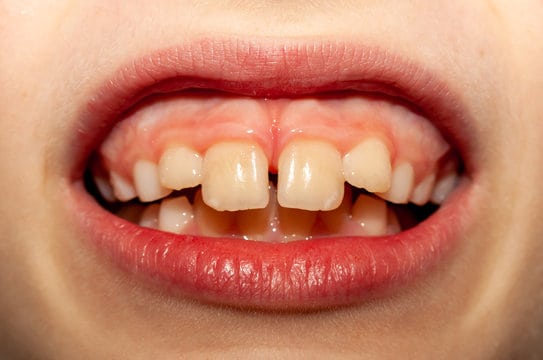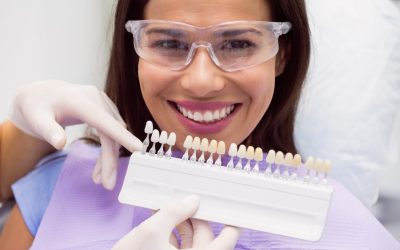Confident smiles often correlate to well-aligning teeth, yet not everyone follows this standard pattern. Some individuals may suffer from protrusion teeth – a dental condition in which the upper front teeth protrude forward, creating an overbite – making their smile less appealing. Gaining insight into what protrusion teeth are, their causes and available treatments is critical to creating healthier and more appealing smiles. In this comprehensive guide, we will examine protrusion teeth in depth, exploring their causes and impact on oral health and ways of correcting them to achieve healthier, more pleasing, and aesthetically pleasing smiles.
Embrace the transformation, let your smile be the masterpiece. Straightening the path to confidence, one dental adjustment at a time.
What Are Protrusion Teeth?
Protrusion teeth (commonly referred to as an overjet or an overbite) is a dental condition whereby the upper front teeth extend significantly forward relative to their counterparts on either side. This misalignment creates an imbalanced bite, leading to functional and aesthetic issues for those affected by protrusion teeth. Protrusion teeth may manifest themselves differently but generally fall into two primary categories:
Dental Protrusion:
Dental Protrusion occurs when the upper front teeth (incisors) protrude forward relative to their counterparts in the lower jaw, known as overjet. This condition typically results from excess overlap between upper and lower jaw teeth, causing an unbalanced bite and creating an imbalanced bite pattern.
Causes of Protrusion Teeth
Understanding the causes of protruding front teeth or back teeth is vital for developing an appropriate treatment strategy. Numerous factors contribute to this condition, including:
Genetics:
Genetics plays an integral part in dental development. If parents or grandparents had protrusion teeth, their offspring would likely inherit this trait more readily.
Childhood Habits:
Prolonged thumb-sucking, pacifier use, or bottle feeding after infancy may adversely impact tooth alignment and lead to tooth protrusion.
Missing Teeth:
Gaps created by missing teeth can throw the balance of the mouth off-kilter, leading to Protrusion as adjacent teeth shift into their spaces and fill in these empty spaces.
Tongue Thrusting:
Some individuals may develop the habit of thrusting their tongue against their front teeth when swallowing, which may push the upper teeth forward, causing Protrusion.
Signs and Impact on Oral Health
Protrusion can have severe repercussions for oral health and overall wellness:
Difficulty Biting and Chewing:
An imbalanced bite can render biting and chewing less effective, potentially leading to discomfort or jaw pain.
Speech Difficulties:
Protruding teeth may interfere with speech patterns, leading to lisping or difficulty pronouncing certain sounds.
Increased Risk of Dental Injuries:
Protrusions on upper front teeth increase the risk of dental injuries in accidents or trauma, making these upper front teeth susceptible to damage.
Oral Hygiene Challenges:
Cleaning protrusion teeth can be more complex, increasing the risk of decay and gum disease.
Self-Esteem and Confidence:
Protrusion teeth may hurt one’s self-esteem and confidence, negatively influencing social and emotional well-being.
Treatment Options for Protrusion Teeth
Protruding teeth correction treatment addresses their causes and creates a balanced, functional bite while improving the smile’s aesthetics. Here are some standard options:
Dental Protrusion:
Orthodontic treatment of dental Protrusion focuses on realigning the upper incisors with their counterparts below, producing a harmonious bite and creating harmony within.
Skeletal Protrusion:
Treatments for skeletal Protrusion may include braces and functional appliances to correct jaw discrepancies. Headgear or Forsus appliances may also encourage the proper growth and alignment of the jaw.
Functional Appliances:
Functional appliances like headgear or Forsus appliances may be utilized in cases of skeletal Protrusion to promote proper jaw growth and alignment and should generally be utilized by adolescents who are still growing. Such devices may also help in cases of orthodontic Protrusion in children and teenagers.
Orthodontic Treatment:
If thinking, can braces fix protruding teeth? Orthodontic interventions are often the preferred means to correct Protrusion of teeth. Braces – whether traditional metal braces, ceramic braces, or clear aligners such as Invisalign – can gradually move teeth back into their appropriate places throughout treatment, depending on how complex the case may be. Treatment duration will depend on its complexity.
Surgical Correction:
Orthognathic surgery may be the answer for severe cases of skeletal Protrusion. This procedure repositions both upper and lower jaws into proper positions to achieve proper bite alignment, typically recommended as part of adult orthodontic therapy if orthodontic treatments alone cannot effectively address an issue.
Retention:
Following active treatment, retainers are essential to maintaining results and preventing relapse. Wearing retainers regularly helps stabilize teeth in their correct positions.
Aesthetic Considerations in Protruding Teeth Correction
Beyond functional considerations, treating Protrusion of teeth also typically involves aesthetic ones. Achieve an appealing and balanced smile should be the primary goal of treatment and may include measures such as:
Smile Aesthetics:
Orthodontic treatment for protrusion teeth addresses an overjet and focuses on creating an aesthetically pleasing arc and proportions in the smile arc and tooth arrangement.
Lip and Facial Profile:
Correcting jaw alignment may improve overall facial profile, including balance between lips and nose.
Final Words
Protrusion teeth can negatively impact oral health and aesthetics, diminishing quality of life. With advancements in orthodontic and dental treatment options, protrusion correction is increasingly achievable. Seeking early evaluation and treatment from an orthodontist is vital in effectively treating this condition and avoiding potential complications; remember, a beautiful, aligned smile enhances appearance and contributes to improved oral health and overall well-being. If you are looking for the best dentist, Dr. Savita has got you covered. Visit her for the best treatments and experience the best difference in no time.




